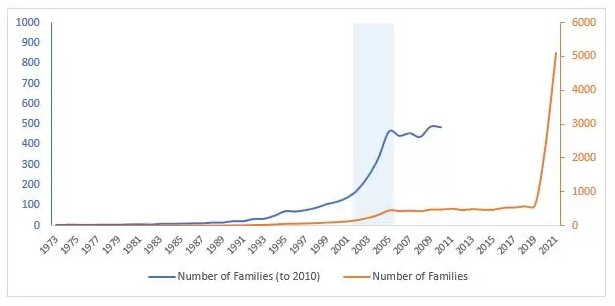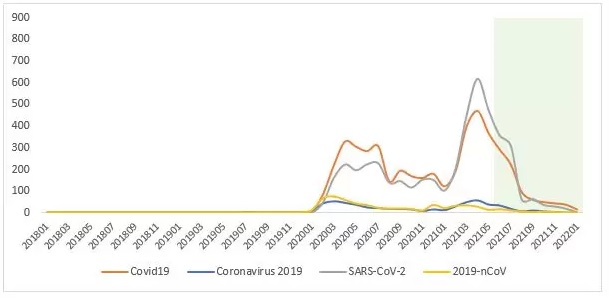- within Privacy and Corporate/Commercial Law topic(s)
- with Senior Company Executives, HR and Finance and Tax Executives
- with readers working within the Banking & Credit, Healthcare and Law Firm industries
Covid-19 is not just a once-in-a-lifetime pandemic sweeping across the globe causing hardships and sorrows; it's also a new word, and the opportunity to look at it through a patent lens is similarly a once-in-a-lifetime event.
Covid-19 has been around for some two years, so why look at it now? Patent applications are typically published 18 months after the first application, usually the priority application. It makes for an information black hole over that time. Sometimes we know some basic bibliographic details such as title and applicant, but the rest of the specification is hidden. Applications made in late 2019 or early 2020 weren't published until about mid 2021, and that's just seven or eight months ago.
We're going to look at a few particular keywords relating to
Covid-19, and we're going to stick to the title, abstract and
claims because these are where the applications directly related to
solving the problem will mention the keywords.
Simply, the search string is TAC=(covid, covid19, (corona* w2
2019), (sars w2 cov w2 2), (sars w2 cov2), ((19, 2019) w2 (ncov,
hcov))).
The first keyword is Covid or Covid-19. Covid-19 is one of the official names designated by the WHO, and comes from Corona Virus Disease 2019. It's used widely to refer to the disease, and more loosely to the virus itself.
The second keyword is essentially Coronavirus 2019, coming from the long form text of Covid 19.
The third keyword is SARS-CoV-2. It's an official name for the virus that causes Covid-19, designated by the WHO in February 2020.
The last keyword is 2019-nCoV (or 2019-hCoV). This was an early name, originating in January 2020, and comes from the naming conventions for new viruses and diseases, often used to protect groups of people or geographic locations from social stigma. That hasn't stopped certain political figures trumpeting about the Wuhan flu or the China virus though.
Additionally, because of the short time frame, we're going to look month by month rather than year by year so we can get a better look at the data.
But before we get to the data, there's one significant keyword that's been left out, and that's "coronavirus" (or "corona virus"). Coronaviruses are not new. They cause mild infections in humans such as a common cold but also more acute respiratory illnesses such as SARS and MERS, and now also Covid-19. I've charted the number of patent families using coronavirus as a keyword in the title, abstract and claims, and use of the term has skyrocketed in the last couple of years (in orange). But you can also see a dramatic rise from about 2003 to 2005 before levelling off for another decade or so. I've charted that on a separate scale (in blue) so it can be seen more clearly. This dramatic rise coincides with the outbreak of SARS in late 2002, and the efforts made to find a treatment.
There was no such rise with the outbreak of MERS in 2012 (and other outbreaks in 2015 and 2018). There were only low numbers of cases and it's not easily transmissible so, perhaps new treatments were not as much of a priority.

The natural assumption about data on a new keyword is that, prior to it being coined, there should be no records found, but you do have to check, so it was surprising to find two publications specifically mentioning Covid-19 prior to December 2019. Is that the murmurings of a whisper of conspiracy theorists I hear? Don't worry, there are two far more mundane explanations.
US20210404023 is part of a patent family including WO2021/155638, and it stems from this PCT application as a national phase entry. So how did it get an application date for April 2010? First off, the application date is exactly ten years earlier than the other family members, so there's a typo somewhere in the system that turned 10 April 2020 into 10 April 2010. It gets worse though. The US register, PAIR, has the filing date as 1 May 2020 on one page and 10 April 2020 on another. It's a mess.
US20200330792 is an application made in July 2018 for an antimicrobial wand, but the applicant couldn't get its patent formalities in order, so it was abandoned. The applicant was also given notice to file a corrected application in February 2020, so it took the opportunity to tack "Covid 19" on to the end of one of their old claims before resubmitting. The new application passed formalities and was published in October 2020 but with an application date prior to Covid-19 arising. It's also been abandoned again.
With that, here is the data showing the number of patent families with applications filed each month from January 2018 through to January 2022 that mention one of the keywords described above. We've gone for a long lead in time to show you just how these keywords have arisen out of nowhere.

There's a green shaded area covering the last eight months. The data in this region is incomplete because we're waiting for the remaining applications filed eighteen months ago to be published. The drop in filings leading into the shaded area could be where the trend is heading. Alternatively, there could be enough publications in the coming months to continue the upward trend. We just don't know yet.
One other thing. The data above is not mutually exclusive. An application might mention all keywords or it might just mention one, but it will get counted every time a keyword is used.
As we have experienced in our own lives, Covid-19 comes in waves, and so have the filings. We even see the second wave peaking at a higher level than the first. It would be hard to map the data to the actual waves of the disease. Different countries experienced these at different times, and we haven't gone deep enough to see where each patent family originated from.
Looking at the keywords, Covid-19 and SARS-CoV-2 follow similar paths, but are not always found together in the applications filed. Actually, they are more likely not to appear together. In the period where Covid-19 dominates as a keyword, roughly March to October 2020, other keywords strongly relate to prevention, treatment and disinfection, and this could be seen in the initial public health response with mask wearing and hand sanitising. In the period where SARS-CoV-2 dominates, roughly February to July 2021, we see keywords such as spike protein, nucleic acid, vaccine and antibodies, and we have seen this exemplified with several vaccines developed and vaccination programs occurring throughout the world. July 2021 is also where we bump into the start of the publication black hole, so perhaps SARS-CoV-2 and associated vaccine development will continue to reign for a while yet.
The other keywords, Coronavirus 2019 and 2019-nCoV also follow similar paths but are less likely to be mentioned in a new application.
This is no surprise. The name 2019-nCoV existed for only a month or so before being replaced with the official names, and so while it might get a mention here and there on an individual basis, it more likely appears as part of a list or in parentheses. Coronavirus 2019 is much more of a mouthful than Covid-19, and has likely fallen in usage as other terminology dominates.
Patent searching is always an iterative process. We can consider a range of keywords for a concept and think we have them all, or at least the ones that matter most, but often another will crop up while the search is conducted. We must go back and add this newfound keyword to the search strategy. These are existing words that we find. It's not often that a new word finds us.
The content of this article is intended to provide a general guide to the subject matter. Specialist advice should be sought about your specific circumstances.



